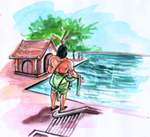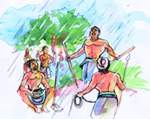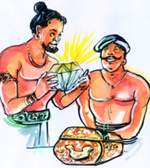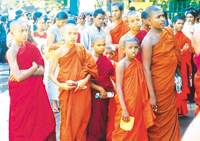|
This
article is part of a continuing series on the 'Mahavamsa', the recorded
chronicle of Sri Lankan history. King Pandukabhaya
was grateful to all those who helped him, in his struggle for kingship.
To the east of the city, he built a shrine for the 'Yakkha' Kalavela.
A shrine for Chittaraja was built near the Abhaya tank. He conducted
religious rites to respect both these 'Yakkhas'. The day Pandukabahaya
celebrated his victory, he had bathed in a pond. He enlarged that
pond, converted it to a tank and named it the tank 'Jaya'. Abhaya
tank built by Pandukabhaya, is known as Basavakkulama today. He
built a King Pandukabhaya
is famous for building the city of Anuradhapura. It is believed
that his town planning was as advanced as the modern day town planning.
He was deeply concerned about the cleanliness of the city. He had
employed 500 men to clean the streets, another 200 for cleaning
sewers and yet another 150 for bearing the dead bodies. All these
workers belonged to the 'Chandala' caste. To the north west of the
cemetery, houses were erected for all these categories of workers.
They were paid regular wages too. To the east of the cemetery, a
house was built for 'Nigantha' Jotiya. (A monastery of a religious
sect) In the 10th
year of his coronation, King Pandukabhaya demarcated all the villages.
He succeeded in changing the lineage of King Vijaya. King Pandukabhaya
supported the 'Yakkhas', who are believed to be the earliest settlers
of this country. It was they who looked after Pandukabhaya, from
his early childhood. As such, he was very generous in giving them
whatever conveniences they needed. Some believe that the majority
of King Pandukabhaya, who was 37 years old, when he ascended the throne, is believed to have ruled for 70 long years. According to the 'Mahavamsa', it was his son Mutasiva, who succeeded him. But the 'Rajavaliya differs here, mentioning another son, who is said to have ruled before Mutasiva. Mutasiva has ruled the country peacefully. He is responsible for developing the park - 'Mahamevna'. The day the king demarcated the boundaries of this park, an untimely, heavy downpour was experienced. Hence the name 'Mahamegha Vana'- which later was simplified to Mahamevna. King Mutasiva ruled from 367 BC to 307 BC. King Mutasiva
had 10 sons and two daughters. Devanampiyatissa was the second son.
His virtue and intelligence made him popular among his subjects.
When King Mutasiva passed away, Devanampiyatissa ascended the throne.
Even the Mahavamsa mentions Treasures and jewels that had been buried deep down had risen to the surface of the earth. Jewels were seen upon the earth. All this is believed to have taken place, due to the merit of Devanampiyatissa. The king was glad to notice all this. He thought of sending some of these jewels to his unseen friend Dharmashoka of India. The king thought only he was worthy to receive a share of this priceless treasure. The Chief Envoy appointed to take the treasure to India was his nephew, Arittha. There were a few others to accompany him. Among them were his chief Chaplain, a minister and a treasurer. They had embarked at 'Jambukola' and in seven days, he had reached the city of Pataliputra in India. Stamp
News 248 On an earlier
occasion, two stamps were issued to mark the 50th Anniversary of
the establishment of diplomatic relations between Japan and Sri
Lanka. The 80 yen Japanese stamp carried a picture of a Sigiriya
fresco. The Sri Lankan stamp featured Mount Fuji. The stamps were
released on 12 April 2002. (See Stamp News 217). The Exhibition
Centre is in the same premises as the Bandaranaike Memorial International
Conference Hall (BMICH) and has been constructed in honour of the
distinguished service rendered by Mrs Bandaranaike for the sake
of world peace as the first woman Prime Minister of the world and
as the leader of the non-aligned nations. She was a founding member
of the Belgrade Conference, which considered war as a bane of the
people of the world. She adopted a neutral foreign policy to organize
the world community in order to settle the Indo-China crisis, which
was likely to bring about a great catastrophe to entire Asia. During
Mrs Bandaranaike's tenure as head of the non-aligned nations, the
BMICH was the venue of the 1976 Non-aligned Nations Conference. With the establishment
of the Exhibition Centre adjacent to the BMICH, Colombo can now
offer the world a rare opportunity of holding any international
conference and exhibition in Sri Lanka. This facility should also
boost the tourist industry. Just as much as the BMICH became the
largest of its kind in South East Asia, so will be the Exhibition
Centre, among similar institutes in the region. The opening of the
Centre coincided with the 30th anniversary of the opening of the
BMICH. The stamps
issued by Sri Lanka and China feature the Exhibition Centre . The
Sri Lankan stamp also carries a portrait of Mrs Bandaranaike and
is horizontal in format measuring 60x25 cm. It is virtually identical
to the horizontal stamp released on 27 November 2001 to mark the
25th anniversary of the S W R D Bandaranaike Memorial National Foundation.
That stamp carries a picture of the BMICH and the portraits of Mr
& Mrs Banadranaike. Both stamps have been designed by Palitha
Gunasinghe. Mrs Bandaranaike (1916-2000) had the rare distinction of becoming Prime Minister three times. She was Prime Minister from July 1960 to March 1965 and then from 1970-77. The third stint was from November1994 until August 2000 when she resigned due to ill health. World
Envronment Day Children from all over the country, including farflung places like Vavuniya attended the gathering. |
||||
Copyright © 2001 Wijeya Newspapers
Ltd. All rights reserved. |
 number
of shrines to respect various religious figures.
number
of shrines to respect various religious figures. soldiers
in his army came from the tribe of 'Yakkhas'.
soldiers
in his army came from the tribe of 'Yakkhas'. that
several miracles occurred on the day of his consecration ceremony.
that
several miracles occurred on the day of his consecration ceremony. The
United Nations World Environment Day was celebrated in Colombo on
June 6, 2003. Participants paraded the streets, starting from the
Vihara Mahadevi Park, carrying placards protesting against the destruction
to the environment in Sri Lanka.
The
United Nations World Environment Day was celebrated in Colombo on
June 6, 2003. Participants paraded the streets, starting from the
Vihara Mahadevi Park, carrying placards protesting against the destruction
to the environment in Sri Lanka.